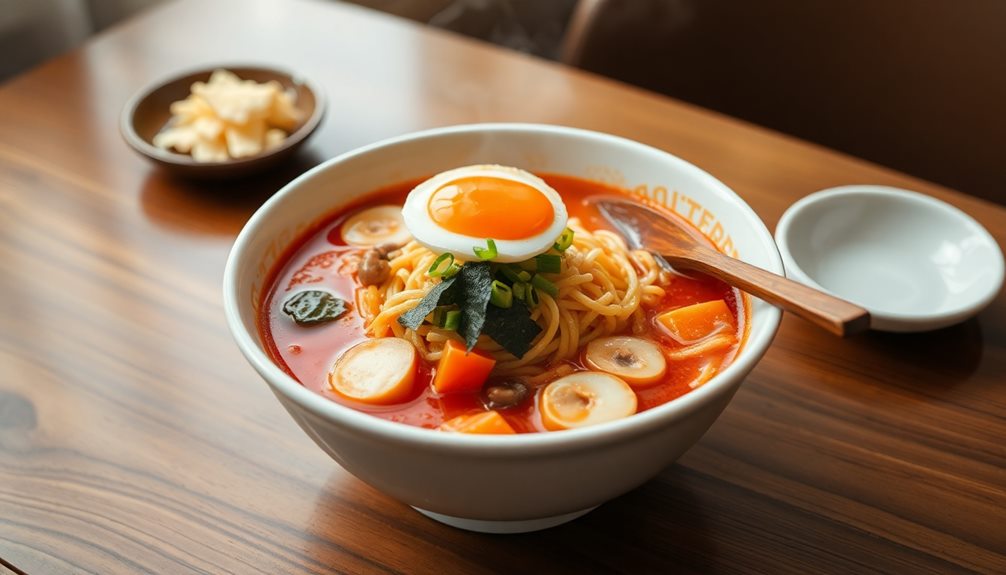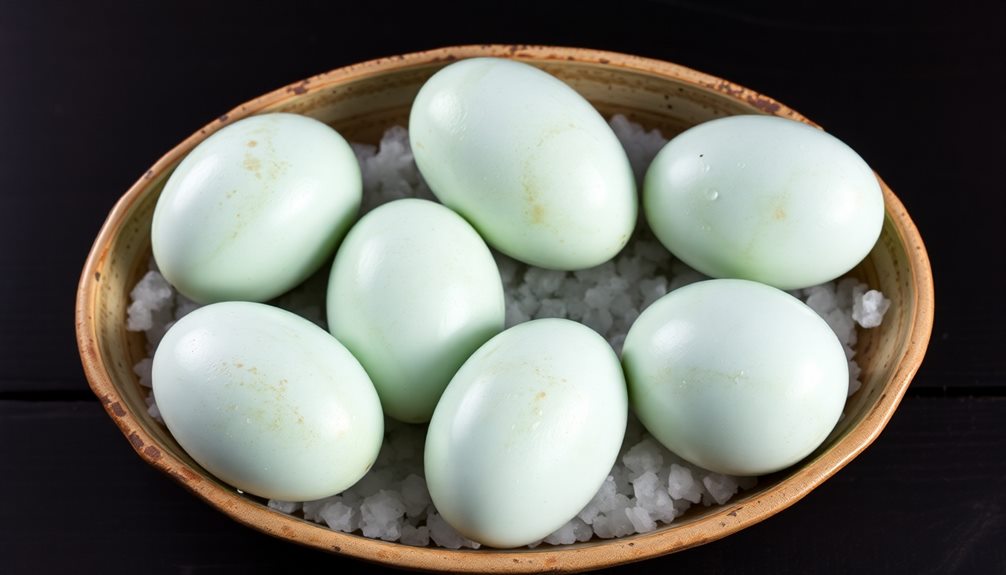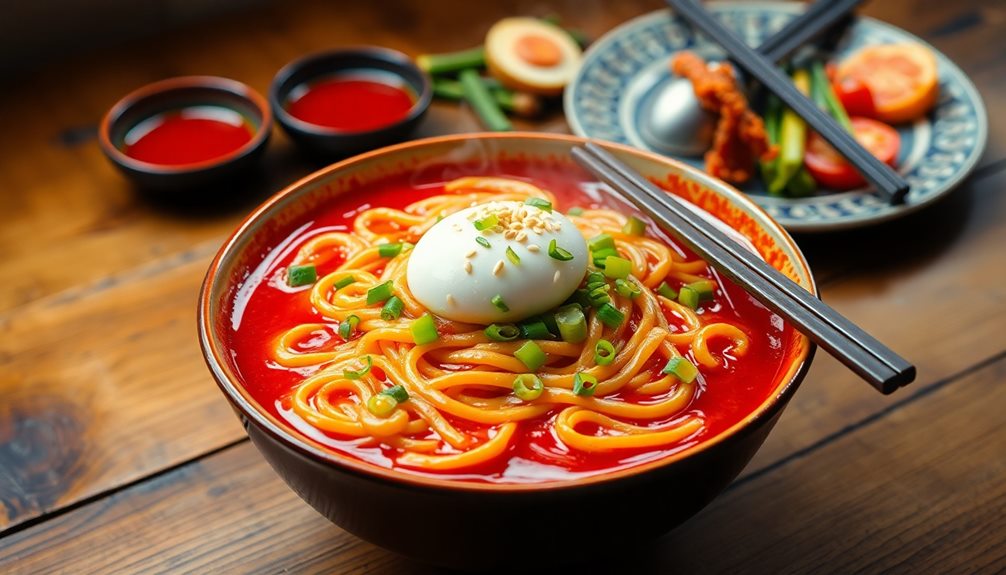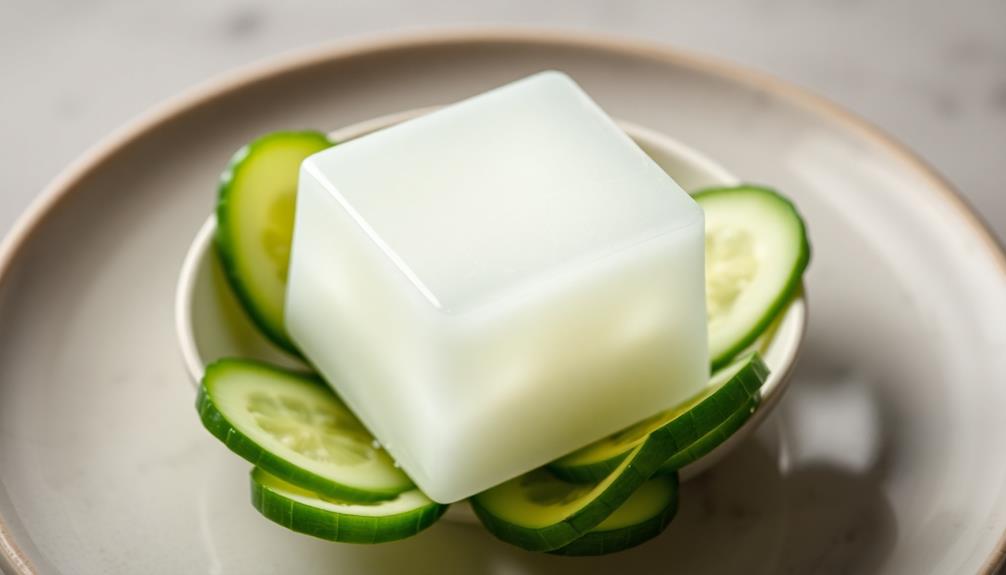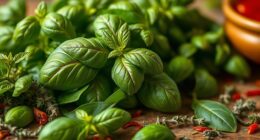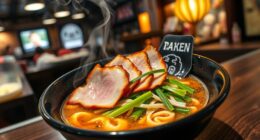Korean ramen and Japanese ramen are both delicious, but they have some exciting differences! Korean ramen usually has a spicy kick from gochujang, while Japanese ramen focuses on rich, savory flavors with ingredients like soy sauce or miso. Their noodles also vary; Korean uses instant noodles that cook quickly, while Japanese noodles are often fresh and chewy. Plus, the toppings are different—think kimchi and boiled eggs for Korean ramen versus chashu pork and green onions for Japanese. Each type brings a unique taste to your bowl, so why not explore them both for a tasty adventure? More tasty details await!
Key Takeaways
- Korean ramen is known for its spicy flavors, often incorporating gochujang, while Japanese ramen emphasizes umami with soy sauce or miso broths.
- Korean ramen typically includes diverse toppings like kimchi and seaweed, whereas Japanese ramen features chashu pork, green onions, and soft-boiled eggs.
- Preparation methods differ, with Korean ramen often using instant noodles and Japanese ramen favoring fresh noodles for a chewier texture.
- Broth preparation varies, as Korean ramen focuses on a quicker, spicier broth, while Japanese ramen often requires a longer simmer for depth of flavor.
- Both styles reflect cultural exchanges, showcasing unique regional variations and culinary histories in their respective countries.
History
The rich history of ramen reflects the cultural exchanges between Korea and Japan, showcasing how culinary traditions evolve over time. You might be surprised to learn that ramen actually has roots in China! It first made its way to Japan in the late 19th century when Chinese immigrants opened noodle shops. The Japanese loved the dish, and it quickly became popular. Over the years, Japan adapted the dish, incorporating local flavors and ingredients, giving rise to the iconic bowls we know today. The ramen origins and cultural roots highlight a fascinating story of cross-border influence, where a Chinese staple transformed into a uniquely Japanese comfort food. This interconnected culinary journey underscores the power of food in bridging cultures and creating shared traditions.
In Korea, ramen took on a unique twist. After World War II, instant ramen was introduced, making it a convenient meal for busy families. Korean ramen often features spicy flavors and a variety of toppings, like vegetables and eggs.
Both countries' versions of ramen show how food can tell stories about culture and history. You can see how ingredients and cooking methods changed as people shared their food traditions.
Today, ramen is a beloved dish in both Korea and Japan, but each country adds its own special touch. So, whether you enjoy a spicy Korean bowl or a savory Japanese one, you're savoring a piece of history!
Embrace the flavors and stories behind your next ramen meal, and you'll appreciate it even more.
Cooking Steps
When you're ready to dive into the world of Korean and Japanese ramen, understanding the cooking steps is crucial for achieving that authentic taste.
First, gather your ingredients. For Korean ramen, you'll need instant noodles, broth, vegetables, and maybe some spicy gochujang. For Japanese ramen, focus on fresh noodles, rich broth, and toppings like chashu pork and green onions.
Next, boil some water in a pot. If you're making Korean ramen, add the instant noodles and cook for about three to four minutes until they're soft. Stir in the seasoning packet and any gochujang for that spicy kick.
For Japanese ramen, cook the fresh noodles according to the package instructions, usually around two to three minutes.
Once your noodles are ready, it's time to assemble your bowl. Pour your hot broth over the noodles and add your favorite toppings.
For Korean ramen, toss in some kimchi or a boiled egg. For Japanese ramen, layer on the chashu and sprinkle green onions.
Step 1. Prepare Broth Ingredients Separately
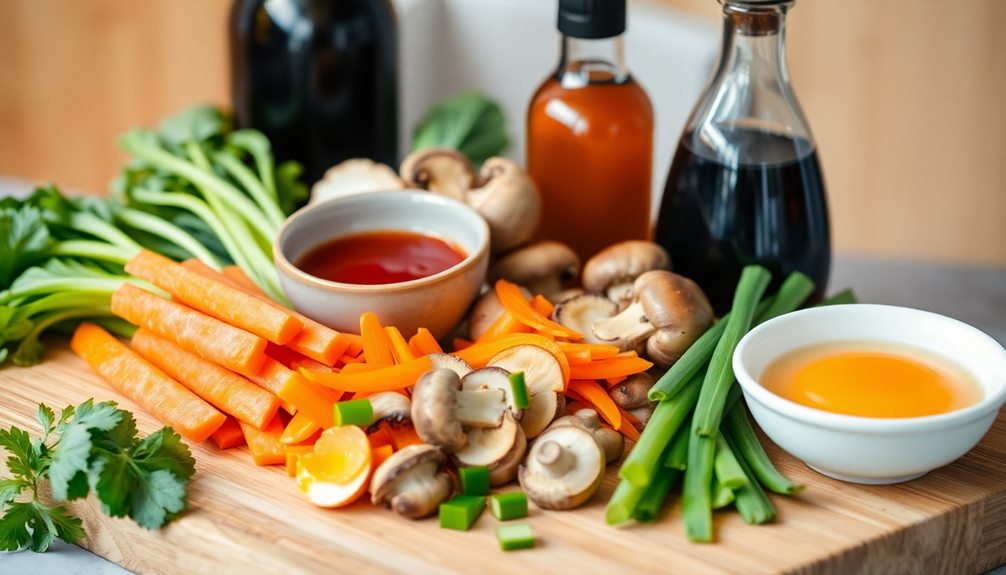
To create a rich and flavorful broth, preparing the ingredients separately is key. Start by gathering your essential components, like bones, vegetables, and aromatics. If you're making Korean ramen, you might choose beef bones for a hearty base, while Japanese ramen often uses chicken or pork bones for a lighter touch.
Next, roast the bones in the oven for about 30 minutes. This step adds a delicious depth to your broth.
While the bones roast, chop up your vegetables like onions, garlic, and ginger. You'll want to sauté these in a pot with a bit of oil until they're soft and fragrant.
Once the bones are ready, transfer them to your pot of sautéed veggies. Fill the pot with water and let it simmer! It's important to let the broth cook for a while, so the flavors meld together beautifully.
Skim off any foam that rises to the top to keep your broth clear.
Separately preparing these ingredients helps you build a robust flavor profile, setting the stage for the delicious ramen you'll create!
Enjoy the process, and know you're making something truly special.
Step 2. Add Seasonings and Flavorings
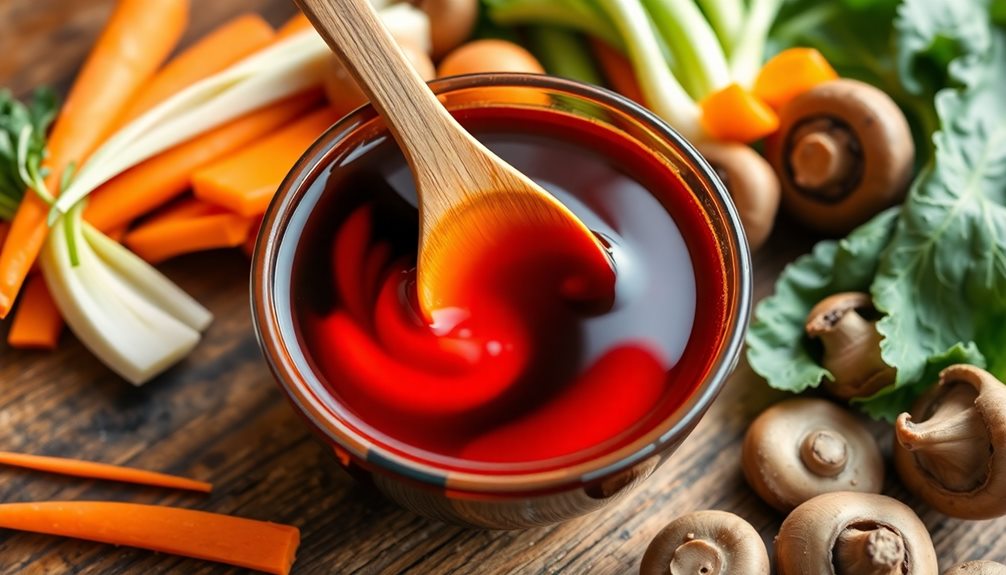
Once your broth has simmered to perfection, it's time to enhance its flavor with seasonings and flavorings. This step is where the magic happens!
Start by adding soy sauce or gochujang for that delicious umami kick. If you're making Japanese ramen, you might prefer a splash of mirin for a touch of sweetness. For Korean ramen, adding sesame oil gives a nutty flavor that warms your heart.
Next, consider garlic and ginger. They're like the dynamic duo of flavor! Mince or grate a little and stir it in.
Don't forget to add some salt and pepper, too, but taste as you go. You want to make sure you don't overpower the broth.
If you're feeling adventurous, sprinkle in some chili flakes or a dash of hot sauce for a spicy twist. Remember, it's all about finding the right balance that suits your taste buds.
Once you've added your seasonings, let the broth simmer for a few more minutes to let those flavors blend together beautifully. Trust me, your kitchen will smell amazing!
Now you're ready for the next exciting step!
Step 3. Incorporate Noodles and Toppings

With your flavorful broth ready, it's time to bring your ramen to life by incorporating the noodles and toppings. First, grab your noodles! If you're using fresh noodles, they'll cook quickly, usually in just a couple of minutes. For dried noodles, follow the package instructions. Once they're soft, gently swirl them into your bubbling broth. You'll see your beautiful creation start to take shape!
Next, let's add the toppings. This is where you can get really creative! For Japanese ramen, consider adding slices of tender chashu (braised pork), green onions, and a soft-boiled egg with a gooey yolk.
If you're leaning towards Korean ramen, try some kimchi for a spicy kick, or even pieces of seaweed for a tasty crunch.
Don't forget the finishing touches! A sprinkle of sesame seeds or a drizzle of chili oil can elevate your dish even more. As you place everything into your bowl, take a moment to appreciate the colors and textures.
It's not just a meal; it's a work of art! Now, grab your chopsticks, and get ready for a delicious ramen experience!
Step 4. Simmer for Optimal Flavor
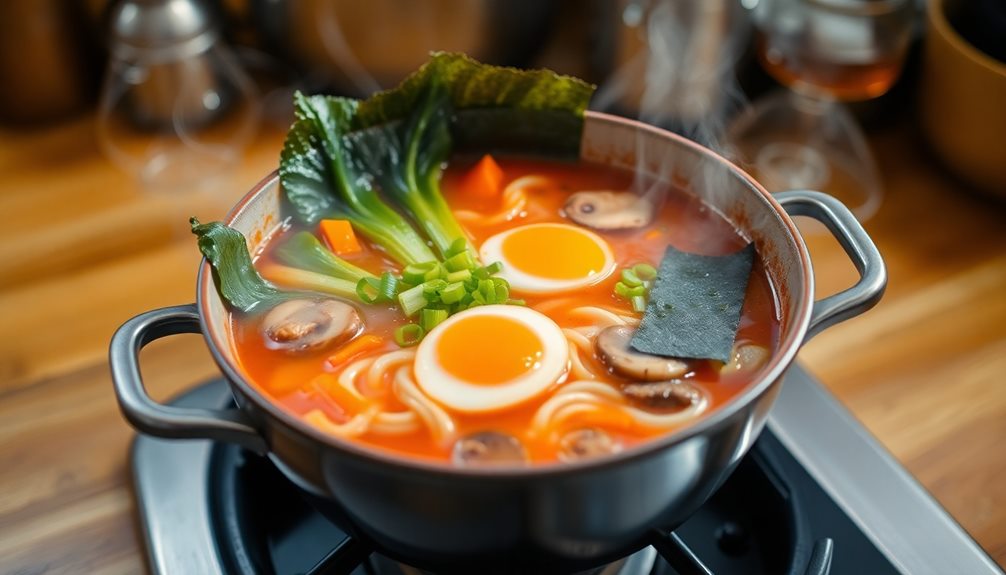
You'll want to simmer your broth for at least 30 minutes, but if you can, aim for an hour or more. The longer you simmer, the more the flavors will deepen.
Keep an eye on it and stir occasionally, so nothing sticks to the bottom of the pot. If you notice any foam or scum floating on the surface, skim it off with a spoon. It helps keep your broth clear and tasty!
As it's simmering, your kitchen will fill with wonderful aromas that'll make your mouth water. Trust me, you'll be so excited to taste the results!
Step 5. Add Garnishes Before Serving
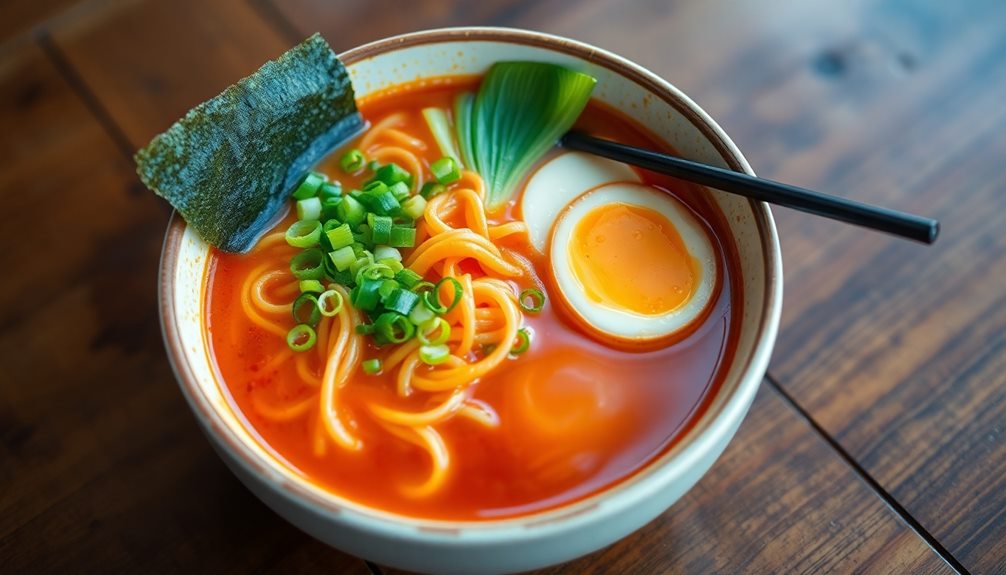
Before serving your ramen, adding garnishes elevates the dish and enhances its visual appeal. Think of garnishes as the finishing touches that make your ramen look and taste amazing!
You can sprinkle some sliced green onions on top for a fresh crunch. Don't forget about nori, the seaweed that adds a bit of ocean flavor and a cool texture. If you want to make it extra special, add a soft-boiled egg, cut in half, so you can see that lovely, runny yolk.
You can also toss in some sesame seeds for a nutty flavor and a nice pop of color. For those who like a little spice, a drizzle of chili oil or a sprinkle of red pepper flakes can really kick things up!
When you're ready to serve, take a moment to arrange everything beautifully in the bowl. This isn't just about taste; it's about making your meal look appetizing, too!
Final Thoughts
The debate between Korean and Japanese ramen reveals a rich tapestry of flavors and traditions that each culture brings to the table.
You might find it exciting to explore the differences and similarities between these two delicious dishes!
Korean ramen often has a spicy kick, thanks to ingredients like gochujang, which gives it a unique flavor.
On the other hand, Japanese ramen tends to be more about umami, with rich broths made from soy sauce or miso.
When you taste these ramens, you're not just enjoying a meal; you're experiencing a part of each culture's history and creativity.
Whether you prefer the heat of Korean ramen or the comforting warmth of Japanese ramen, there's no wrong choice!
It's all about what makes your taste buds dance with joy.
Frequently Asked Questions
What Are the Primary Ingredients in Korean Ramen?
Korean ramen typically includes wheat noodles, spicy broth, and various seasonings. You'll often find ingredients like gochujang, kimchi, and vegetables. It's a flavorful dish that's known for its bold, spicy kick. Enjoy!
How Does the Spiciness of Korean Ramen Compare to Japanese Ramen?
When you taste Korean ramen, you'll notice it's generally spicier than Japanese ramen. The bold flavors and heat from ingredients like gochugaru really kick things up, while Japanese ramen tends to be milder and more savory.
Are There Vegetarian Options for Korean and Japanese Ramen?
Absolutely! You can find vegetarian options for both Korean and Japanese ramen. Look for varieties that use vegetable broth and fresh veggies. Just check the ingredients to ensure there are no hidden animal products. Enjoy!
What Types of Noodles Are Commonly Used in Both Ramen Styles?
You'll find that both styles typically use wheat noodles, but their thickness and texture can differ. Korean noodles might be chewier, while Japanese noodles can be smoother. Enjoy exploring these delightful variations in your meals!
Can I Find Authentic Korean or Japanese Ramen Outside Their Countries?
You can definitely find authentic Korean or Japanese ramen outside their countries. Many restaurants specialize in these dishes, and some even use imported ingredients. With a bit of exploration, you'll discover delicious options nearby.
